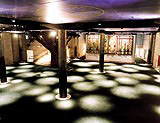Bard sanctuary
The rebuilding of the Globe theatre is a 30-year tale of red tape and financial hold-ups. Nick Smurthwaite picks up the story of the award-winning London attraction

A kind of creative schizophrenia prevails at Shakespeare’s Globe. On the one hand, the organisers are desperate to restore long-forgotten 16th century crafts and practices in the production of their shows. On the other, they eagerly deploy all manner of state-of-the-art technology behind the scenes.
A sumptuous multimedia museum, costing £6.5 million and devoted to the recreation of the Globe, Elizabethan theatre and the plays of Shakespeare, aims to ingeniously bring the two ends of the spectrum together.
The Underglobe, designed by Nick Boulting of Robin Wade and Partners, is housed in a vast yet oddly comforting subterranean space, dominated by a very large and real-looking oak tree (made of plaster), which is presumably there to remind us that the Globe is made almost entirely out of timber. The dappled sunlight, by Light Projects, is suggestive of a forest on a summer’s day.
Ranged around this open space are galleries on two levels, illustrating all you could want to know about the Globe, from scarred mastiff skulls found while excavating the site (bear-baiting was once the big attraction on Bankside) to the dazzlingly ornate ceremonial costume worn by the actress Jane Lapotaire when she dressed up as Elizabeth I to welcome Elizabeth II to the theatre’s opening.
Boulting’s first job was to persuade the client to scale down their aspirations and concentrate on two main areas: the history of the Globe and the history of Shakespearean performance. With the help of user-friendly interactive technology, he has avoided conspicuous information overkill. You can happily wile away an afternoon, yet you don’t come away with Bard fatigue.
Naturally, there is a lot of stuff on the rebuilding of the Globe, an extraordinary 30-year saga thanks to successive bureaucratic and financial hold-ups, and tributes to the late actor Sam Wanamaker, father of Zoe, who made the whole thing happen. How proud he’d have been to find his baby voted Top UK Attraction by British Heritage this year.
For info freaks, there are endless touch-screen displays – courtesy of Cognitive Applications – on 16th century life and entertainments. I particularly liked the one about how special effects such as thunder and cannon fire were achieved in Shakespeare’s time, and another focusing on the printing of Shakespeare’s First Folio. There is even a reconstruction of the elephantine wood-and-metal printing press that would’ve been used to run it off.
A quick blast of creaky old barnstormers like Herbert Berbohm-Tree and Donald Wolfit belting out their Lears and Prosperos makes you feel very grateful to be living in an age of more considered and realistic acting. The wonders of technology also enable those brave enough to indulge in a spot of classical karaoke, recording yourself reciting a chunk of A Midsummer Night’s Dream.
The entrance to the Underglobe is bang opposite the point at which the new Thames footbridge from St Paul’s will meet the bank, so its completion this summer should ensure a steady flow of visitors to the museum. An estimated annual tally of 400 000 visitors is probably not as fanciful as it sounds.
Since the Globe receives no public subsidy, profits from the exhibition will be ploughed into funding an ambitious education centre (complete with two replica Globe stages) in nearby Bear Gardens, as well as a research library. The ultimate goal is to become the world centre for Shakespearean study and performance.
Shakespeare’s Globe is at New Globe Walk, Southwark, London SE1. Contact: 020 7902 1400
-
Post a comment



